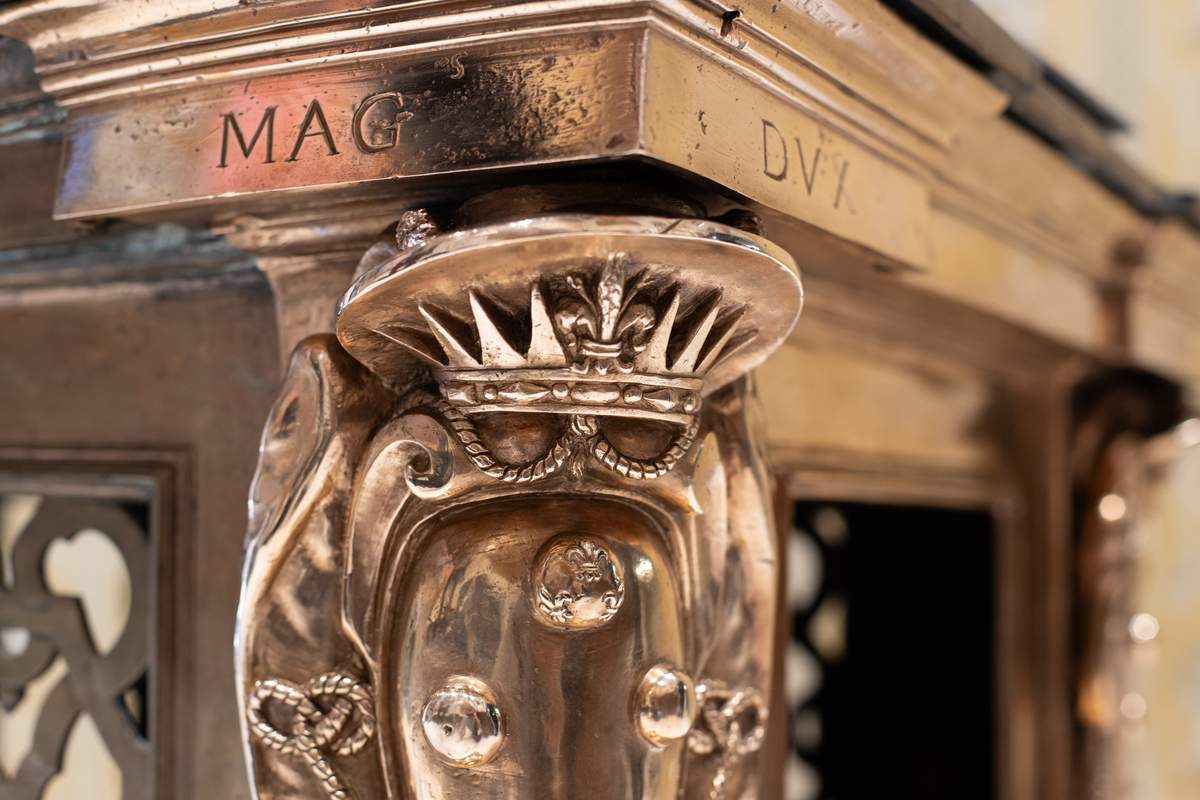From September 12, 2024 to January 8, 2025, the Marino Marini Museum in Florence will host the exhibition The Treasure of the Holy Land at the Marino Marini Museum. The Beauty of the Sacred: The Medici Altar and the Gifts of Kings, to recount more than five centuries of sacred art through masterpieces commissioned by the Catholic courts of Europe to be donated to the basilica of the Holy Sepulcher in Jerusalem. A treasure that has been catalogued by theOrder of Friars Minor since 2013.
The exhibition dedicated to the gifts of sovereigns presents 109 works of sacred art, including theAltar of Calvary from the Jerusalem basilica. This masterpiece, which includes the Ornament donated by Ferdinand I de’ Medici, made by Domenico Portigiani, Giambologna and Pietro Francavilla between 1588 and 1590, constitutes one of the artifacts of greatest artistic and spiritual value adorning the Latin nave of the Holy Sepulcher. For the first time in nearly five centuries, the Ornament has left Jerusalem to return to Italy, where it will be restored and displayed in Florence for the duration of the exhibition.
“The decision to bring the exhibition to the Marino Marini Museum in Florence,” explained Carlo Ferdinando Carnacini, president of the Marini San Pancrazio Foundation, “is dictated by the presence of the Rucellai Chapel, a masterpiece of Renaissance architecture created in the 15th century by Leon Battista Alberti and inspired precisely by the Holy Land Sepulcher. Hosting the treasures of one of the symbolic places of the three religious denominations, a destination for thousands of pilgrims every year, is a source of great pride for our museum. In this combination of contemporary art, tradition and pilgrimage, the Marino Marini Museum in Florence confirms itself as a cultural center of excellence at the international level, capable of promoting dialogue between different artistic languages and bringing a diverse audience closer to the beauty and complexity of art.”
Prominent among the masterpieces in the exhibition are gifts offered by Charles of Bourbon, King of Naples, testifying to the munificence of the patrons and deep devotion. Of particular note is the altar frontal in silver and gold, made in 1731 by Neapolitan master goldsmith Gennaro De Blasio. This is in addition to other unpublished works, never previously exhibited, such as the two canvases depicting St. Francis of Assisi and St. Anthony of Padua, painted by Francesco De Mura in the 18th century. The entire collection of works, placed under the protection of the Custody of the Holy Land, constitutes a treasure trove of religious objects, jewelry, ornaments and sacred vestments, codices and canopies that the Franciscans have preserved and catalogued over more than five centuries. These works will return to Jerusalem in 2026 for the establishment of the historical section of the Terra Sancta Museum in St. Savior’s Convent.
“The tour of the Marini Museum will begin at the aedicule commissioned by Paolo Rucellai for the former church of St. Pancrazio, to guide visitors on a symbolic pilgrimage to the sites of the Holy Land, through centuries of religious devotion and political ostentation,” stressed scientific curator Jacques Charles-Gaffiot. “The display of ’luxury for God,’ through the gift of masterpieces by the most skilled painters, tapestry makers, goldsmiths, and sculptors, represents the contrast between the mystical dimension and the display of power that long competed with the Catholic courts, while also testifying to the opulence of the Medici family in the Renaissance context.”
According to Leyla Bezzi, executive curator of the exhibition, the exhibition is intended to be a journey to Jerusalem divided into three parts:
- An excursion into the history of the Holy Sepulchre: with a preliminary journey into the history of the Jerusalemite basilica, starting with the Rucellai Chapel, which in small dimensions evokes the construction of the Constantinian basilica.
- A geographic pilgrimage: visitors will retrace the ordinary itinerary followed by pilgrims during the stages of the journey to Jerusalem, through engravings taken, for example, from Breydenbach’s “Book of Chronicles,” depicting the ports of Venice and Ancona, that of Jaffa, up to the panoramic view of the Holy City.
- A journey through the masterpieces of Kings: a collection of artworks enriched by donations from the royals of Spain, France, Portugal and the Holy Roman Empire. Followed by Italian treasures from Venice, Genoa, Grand Duchy of Tuscany and Kingdom of Naples. Passing through the Medici Renaissance, Habsburg-Lorraine art, and the modern period.
Image: Calvary Altar, detail of restoration Photo ©Federico Mulas of The Method Agency
 |
| An exhibition at the Marino Marini Museum on sacred art masterpieces donated to the Basilica of the Holy Sepulcher in Jerusalem |
Warning: the translation into English of the original Italian article was created using automatic tools. We undertake to review all articles, but we do not guarantee the total absence of inaccuracies in the translation due to the program. You can find the original by clicking on the ITA button. If you find any mistake,please contact us.